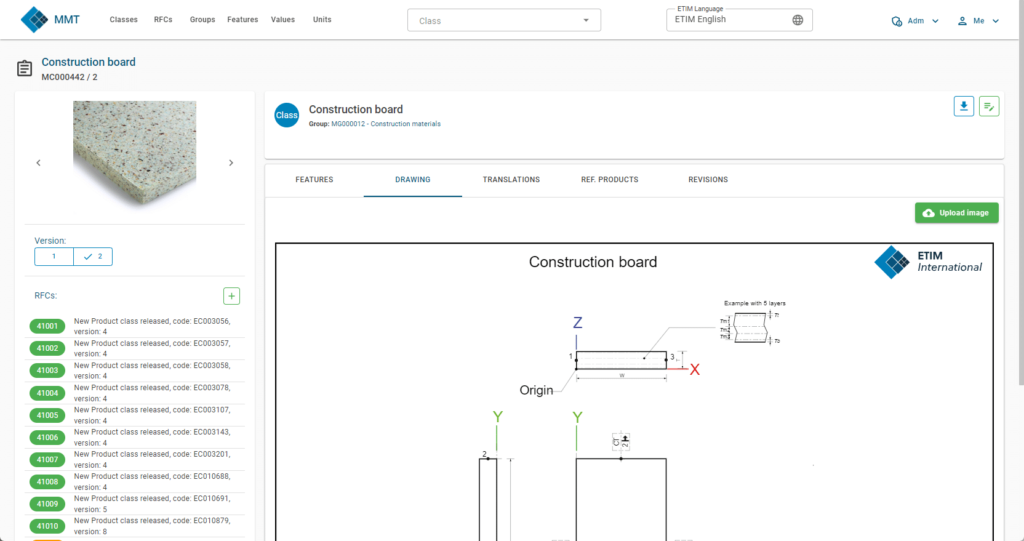With 2023 in full swing, ETIM International is proud to announce their launch of a new online management tool for ETIM Modelling classes this month. ETIM Modelling Classes will be carved out of the existing Classification Management Tool (CMT) to be further maintained in the Modelling Management Tool (MMT). If you already have a viewer account for CMT, be sure to check it out, because we added some interesting new features.
Introducing the new management tool
As of now, the ETIM Modelling Classes will be further developed and maintained in the recently launched Modelling Management Tool, or MMT. Our new management tool can be found here: http://modelling.etim-international.com
This new classification management tool for modelling classes is only accessible with login credentials, which can be obtained at your local ETIM chapter. Non-members and non-contributors can still access the Modelling Classes via the practical ETIM viewer. We hope that this set-up will continue to raise an interest and attract more active members and contributors to help us further develop this standard that was recently introduced internationally.
New: connection type classes
Bragging is not our style, but we have really made some very nifty changes. The first and biggest one, is that within the new standardisation platform we are now able to define connection type classes that can be re-used in modelling classes.
Problem solved
In the first four hundred modelling classes we experienced a great deal of redundant repetition of parametric properties for connections like inner threads or flanges. These occurred on reference drawings as well as in the data model at every connection port. And as some types of connections are used in dozens of classes, maintaining, and updating all parametric features of connections directly and consistently in modelling classes became a challenge, to say the least. No more!
Advantages for BIM object library builders
We need to give credit where credit is due: the BIM object library builders, who started to implement ETIM MC, came up with the idea and started to re-use connection types when they modelled their BIM object. We only formalised their smart thinking into a subclass of modelling classes: connection type classes that can be assigned to the modelling classes at connection port level.
Advantages for manufacturers
With future modelling classes tied to connection type classes, the data set that manufacturers need to maintain and distribute becomes more structured, showing only the relevant properties, resulting in less hassle and easier validation. Now, the only thing to be added is a mapping of connection ports and the connection type class of choice (as listed in the modelling class-definition).
Opportunities for software providers
Connection type classes show plenty of opportunities for new cool features in PIM and MDM systems. Not only is the feature set of the connection type class repetitively used, the instances of connection type classes also show a lot of repetition in data sets. Which makes sense, because a data set for flanges according to EN 1092-1 always has the same set of data, regardless of the product one uses them in. The same applies to threaded connection standards, push fittings and tube-ends. Being able to copy-paste the same set of data at once for a DN 150 flange (EN 1092-1) or a Rp ¾ outer thread (ISO 7-1) would save manufacturers so much time.
With the simplified structure of connection types assigned to ports, it’s bye bye to endless lists of properties: a mere set of base features suffices, along with some additional required features depend on the chosen connection type class per port. Moreover, as validating input with regard to the connectors in the BIM object is so much easier, the quality of data sets will only improve.
Introducing a new versioning system
Even more than with regular ETIM classes, a new extension such as ETIM modelling classes is in a Catch-22 when you look at it from a versioning perspective. Being a young standard in the relatively new field of digitalisation of the building and installation industry, flexibility is key as the need for information can change in a heartbeat. At the same time, building object libraries has proven to be a particularly resource-intensive undertaking, especially since every change on the classification side impacts for instance every manufacturer’s data sets, but also every BIM object involved. Modelling classes require some stability.
With the new versioning system, we believe to have the best of both worlds and tackle three problems at once. By releasing on a class-per-class basis we no longer have work piling up towards release dates, but can spread the work over the entire year. In addition, we put classes in lockdown for a year as soon as they are published. Change requests are still allowed and processed during this time, but saved up for a next release, relieving BIM object template builders of the stress of having to keep up with every single tiny change or improvement.
Any linked classes, whether it be a linked product class, or a new connection type class are also subject to change. Linking only on class code has proven to be risky: you never know beforehand what its impact on ETIM based BIM objects will be. What’s more: not everyone will take BIM modelling into account when requesting a change. Within the new standardisation platform, we added a version code as second key when linking classes together: should linked classes change, a change request will automatically be processed for the modelling class to update according to the latest versions of these linked classes.
Warning: ETIM modelling classes will be carved out of CMT by 30/06/23
To prevent any dead links or non-responsive APIs, we kept a snapshot of ETIM MC as published on the 31st of July 2022 in our classification management tool (CMT). This tool will continue to be our daily instrument for developing, translating, and maintaining the regular ETIM model. We do, however, have to say goodbye at one point to this old snapshot. Software developers and platforms have had time to adjust to the new model and versioning system, and have been able to familiarize themselves with the new API connectors. In the meanwhile the ETIM MC model has developed further and we have to ensure that everyone has moved to using the new platform. The carve-out of modelling classes from CMT is scheduled for 30/06/2023. Please note, that from this day on, software access is limited to the new API endpoints only and users will have to consult either the new ETIM Viewer or the MMT application for referencing, developing and maintaining modelling classes.
About ETIM Modelling classes
If you like to learn more about ETIM Modelling Classes, check this article.
Where to visit the platform
http://modelling.etim-international.com
You can access MMT through the above link. You will need login credentials which can be obtained at your local ETIM chapter office.
Technical documentation
The following technical documentation can be requested at your local ETIM chapter office, or downloaded from out download section:
- Whitepaper about the impact of the migration to MMT and the new API
(to be obtained by sending a request to your local ETIM chapter office or info@etim-international.com) - ETIM Modelling class guidelines
Find your local ETIM chapter office
For more info see our contact page (link: https://etim-international.com/contact)

